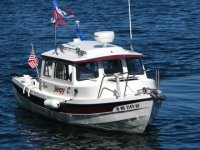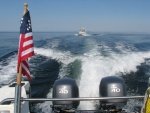colbysmith":cnrntdtq said:
I just flew the Candian Flag on my flagstaff, removing the US Flag until I crossed the border back home. (Positioned on the starboard stern.) Colby
Flying the Canadian flag on the stern staff would make you a Canadian vessel. Not correct.
We have been visiting lands outside of the US in our boats since 1962. We always fly the US National Flag (Not fouled anchor-which should never be flown outside of US waters) at the stern staff. We respected the customs of the country we were visiting. (I was taken to task by a Danish Policeman because we didn't strike our American Flag precisely at 6 PM, as the Copenhagen City hall was lowering theirs.--we were expected to be aboard our boat at precisely 6 PM to comply--and we did.) They expected it to be raised or presented at 8 AM.
The Q (Solid yellow) flag is flown at the starboard spreader or starboard antenna, if no spreader, as a vessel enters a country. Q means my vessel is healthy, I have not cleared in and wish to be granted clearance. After clearing Customs, we replaced the Q flag with the national flag of the country we were visiting. (We carried cloth, and some cloth paint--and sewed/painted some national flags which were not available--we had a collection of 50 national flags.)
A few countries want you to fly the their national flag as soon as crossing their boarder or into their waters. In that case, the Q flag should be flown below the courtesy flag of that country.
It is proper to fly the country's flag at the bow staff, if you have one.
Colors should be made at 8AM and retired at sunset. The Flag of Nationality is the first one made, and the last one retired. There are circumstances, particularly at sea, that flags are flown 24 hours a day.
Review current US Power Squadron flag etiquette here.
The U.S. national ensign, sometimes called "50-star" or "Old Glory," is the proper and preferred flag for all U.S. vessels. Your boat should wear it from 0800 until sunset, and when you enter or leave port during daylight or at night, weather and rig permitting. While in port, if you leave your boat and will not return before sunset, lower and stow the national ensign before you go.
The national ensign worn by a vessel must be the flag of her registry—not necessarily that of the owner or operator.....U.S. national ensign has a 10:19 hoist/fly ratio. (Canadian, British etc are 1:2--pretty close. Italian is 3:2, Mexican is 4:7 Irish is 1:2...these are flags which could be confused)
Size of Flags
Flags are often too small.
The national ensign flown at a flag staff at the stern of your boat should be one inch on the fly for each foot of overall length. Round up if too small.
On powerboats, these flags should be 5/8 inch on the fly for each foot of overall length.
When you visit foreign water, your boat should display a courtesy flag (the civil ensign of the country you are visiting)
If your vessel is mastless, it should wear this "courtesy flag" at the bow,
If your vessel has a single mast: Move any flag normally flown from the starboard spreader, to the inboard starboard halyard or, if your boat has only one halyard per side, to the port spreader halyard.
Do not fly a foreign courtesy flag after you have returned to U.S. waters.
Where many are differing from this, is that courtesy flags are being flown from a Starboard Antenna or outrigger. This is not accepted by US Power Squadron (as above). I have never had a bow staff, and have always flow the courtesy flag on a power boat from a starboard antenna.
Normally a Yacht Club Burgee (C Brat burgee) would be flown from a bow staff. That would be displaced by the national flag of the country you are visiting. On a sail boat, the yacht club burgee and any officer flags would then be flown from the port spreader. Why fly a Yacht club burgee in foreign lands? There are a number of international organizations--for example we flew the burgees of Seven Seas Cruising Association (Commodore) and Ocean Cruising Club so that other members and host would recognize our vessel.


